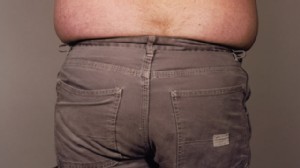The answer is yes.
If you have a body you’re proud of, thanks to hours of lifting weights and watching your diet, you may on occasion show it off by wearing something form fitting, but make sure it’s not TOO constrictive. As a recent news story showed, wearing tight clothing, in this case, “skinny jeans” could land you in the hospital.
Are Your Skinny Jeans TOO Tight?
Recently, a woman donned a pair of skinny jeans to help her friend move to a new apartment. While milling around her friend’s old apartment, she squatted down time after time to pick items up with the skinny jeans hugging her legs. By the end of the day, she could no longer feel her legs because of leg swelling and nerve compression, and fell while walking through a park. When she couldn’t get up, she had to crawl to the side of the road and hail a passing taxi to transport her to the hospital.
Sadly, she went on to spend four days in the hospital getting treatment to repair the damage the form-fitting jeans did to her muscles, nerves, and blood vessels. The swelling in her legs was so pronounced that medical personnel had to cut her skinny jeans off. Lab studies showed she had abnormally high levels of creatine kinase, an enzyme that rises when muscles are damaged.
The diagnosis was rhabdomyolysis and compartment syndrome – a condition marked by the build-up of pressure within a muscle. When muscles swell inside a space that’s too tight, it can quickly damage tissues by blocking the blood supply they need for survival. Muscles are surrounded by fascia, connective tissue that doesn’t stretch or expand easily. So when pressure builds up, it can’t be easily released. People sometimes develop compartment syndrome when they have an arm or leg in a tight cast and less commonly from wearing clothing that’s too tight. Some people are more prone to developing compartment syndrome because their fascia is overly rigid.
Can Wearing Tight Clothing Cause Nerve Damage?
Compartment syndrome from wearing tight clothing is rare, but what isn’t so rare is a condition called meralgia paresthetica, another health problem caused by, among other things, wearing tight pants. With meralgia paresthetica, the lateral femoral cutaneous nerve that supplies sensation to the outer aspect of the thigh is compressed by constrictive clothing, usually a pair of tight pants. Pregnancy, having diabetes, and being overweight are also risk factors for this condition. Fortunately, damage to the nerve usually isn’t permanent, although surgery may occasionally be needed.
If you wear a compression garment or shapewear that makes your tummy and hips look slimmer for a night out on the town, you’re at higher risk for meralgia paresthetica. Better to tone up those areas through exercise than wear something overly constrictive to push in your hips or tummy.
Can Tight Clothing Cause Spinal Problems?
Ask a chiropractor and they’ll tell you not to wear clothing that limits movement of your hips and core. Why? Doing so tightens the muscles that support your spine and throws off your postural alignment. A study published in Applied Ergonomics showed wearing tight pants restricts movement of the lower hips and trunk. As a result, the lumbar spine has to work harder to compensate. It’s always risky to limit movement of one part of the kinetic chain since another part has to take up the slack.
It’s not just tight pants that are a problem but tube and pencil skirts that force you to take short steps and place greater stress on your joints. Combine a tube skirt with high heels and you make the problem even worse by throwing off your center of gravity. Your risk of injury is higher too when you slip into a tight tube or pencil skirt. Ever tried to squat down or bend over to pick something up in a narrow skirt? It’s not easy – or safe.
Don’t forget – you may not feel the impact wearing tight clothing has on you right away, unless you develop an acute injury. Think of the risk as being cumulative over time. Keep in mind that anything that alters your natural gait and stride can create back and spine problems over time.
Digestive Issues and Yeast Infections
Wearing tight clothing around your waist or abdomen increases the pressure inside your abdomen cavity. This pressure pushes up on your diaphragm and can trigger or worsen acid reflux symptoms. So, if you have heartburn, indigestion or bloating after a meal, check to see if your pants are too tight, and if you have on tight clothing, watch how much you eat! Clothing with tight waistbands and belts that constrict your waist or tummy are common culprits as are compression garments like Spanx.
Finally, tight clothing that reduces air flow to your “private parts” place you at greater risk for vaginal yeast infections. When you walk around in tight pants, moisture builds up in your crotch area and serves as a breeding ground for Candida, the fungi that cause yeast infections.
The Bottom Line
Not only is constrictive clothing uncomfortable, it may be hazardous to your health. If you wear something tight, keep it on for the least amount of time possible. Just as you save your stilettos for a special occasion, treat tight clothing the same way. It’s not comfy nor is it healthy. Wearing pants that are tight around the calves is especially risky when it’s warm outside and you’re standing or sitting a lot. The warm weather and standing can cause leg swelling and with tight pants on, your calves can only expand so much, leading to a build-up of pressure.
The take-home message? Be fashionable but sensible about what you put on.
Some clothing-related maladies go by mundane-sounding names that hardly hint at their potential to sicken. For example, a middle-aged or older man whose belly hangs below the waist of his pants may suffer from “tight pants syndrome,” a term coined in a 1993 article by Dr. Octavio Bessa, an internist in Stamford, Conn.
Bessa described a collection of gastrointestinal symptoms including abdominal pain, heartburn and reflux a few hours after meals that he would see in 20 to 25 men every year. The common thread: All wore ill-fitting pants with waistbands several inches smaller than their bellies, Bessa reported in the Archives of Internal Medicine.
Despite treatment with blood thinners, the patient later developed a dangerous pulmonary embolism, indicating a clot had traveled to his lungs.
Women suffer their own tight-pants agonies, too. A gynecological variation can foster yeast infections, pelvic pain, itching and irritations easily mistaken for a sexually transmitted disease. The solution? Looser, cotton clothing.
The way a woman wears her slacks might leave her prone to the breakdown of fatty tissue at the outside of the thighs, called lipoatrophia semicircularis, dermatologists say. “Persistent mechanical pressure” exerted by “strangling folds” of too-tight trousers can impair circulation and set the stage for this condition, especially in women who sit for long periods, according to a study from Chile’s Universidad Andres Bello in the June 2007 Journal of Dermatology.
Wearing tight neckties and shirts with constricting collars can impede blood flow through neck veins and arteries and may affect vision. In a 2003 study of 40 men, half with glaucoma, three minutes with a tightened tie raised eye pressure among the majority of those with and without the disease. Elevated eye pressure is a key element of diagnosing and monitoring glaucoma, a leading cause of blindness.
The lead researcher, Dr. Robert Ritch, a glaucoma specialist at New York Eye and Ear Infirmary, maintained in the study in the British Journal of Ophthalmology that the transient rise in pressure readings “could affect the diagnosis and management of glaucoma.” But several prominent glaucoma specialists said the study failed to establish that transient high pressure from the tightened ties could cause glaucoma.
Tight neckties also can limit neck movement and raise muscle tension in the upper back and neck, researchers at Korea’s Yonsei University reported last year in “Work: A Journal of Prevention, Assessment and Rehabilitation.” They tested 30 computer workers when wearing and not wearing tight neckties and concluded that “it is especially important for male workers to select and tie neckties appropriately” to prevent musculoskeletal injuries.
Although clothing-related pain and dysfunction can affect almost everyone, Avitzur said women have a tendency to overlook discomfort, for the sake of appearance. An admitted fashion health victim, Avitzur said she had worn ill-fitting boots and “too-heavy earrings that tore through one of my lobes.”
She got the idea for a blog about skinny jeans while at the office of the plastic surgeon who repaired the damage from her poor earring choice.
References:
Applied Ergonomics xxx (2013) 1e9. “Effects of restrictive clothing on lumbar range of motion and trunk muscle activity in young adult worker manual material handling”
Medical Daily. “Fashion Victim In Tight Pants Experiences Nerve And Muscle Damage: Medical Conditions Caused By Skinny Jeans” June 22, 2015.
ABC News.go.com



 Pants that are too snug can lead to certain health issues, research suggests. Meaning you can be fit not just overweight.
Pants that are too snug can lead to certain health issues, research suggests. Meaning you can be fit not just overweight. Believe it or not but too-tight neckties might impede proper circulation in severe cases, research suggests.
Believe it or not but too-tight neckties might impede proper circulation in severe cases, research suggests.